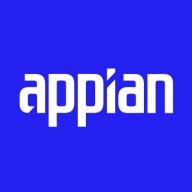

Appian and BIC Platform compete in the business process management space, with Appian showing an advantage due to its robust integration capabilities and adaptable workflow design environment. BIC Platform is favored for its extensive process automation and compliance management, appealing to enterprise-level applications.
Features: Appian offers intuitive process modeling, extensive integration options, and customization capabilities. Its low-code platform facilitates rapid development and deployment. BIC Platform provides advanced process automation tools, comprehensive compliance management, and tailored support for regulatory environments.
Room for Improvement: Appian could enhance its mobile app features, expand its case management capabilities, and improve its user interface customization options. BIC Platform might benefit from reducing its initial setup complexity, increasing scalability options, and lowering maintenance costs.
Ease of Deployment and Customer Service: Appian supports rapid deployment with strong technical support, easing customization. BIC Platform has a more complex setup phase but provides extensive support and training resources for long-term efficiency.
Pricing and ROI: Appian is cost-effective and delivers competitive ROI with adaptable solutions. BIC Platform requires a higher initial investment but provides substantial ROI through enhanced compliance and automation benefits.

Appian is a unified low-code platform and solution used by businesses to build enterprise applications and workflows. This product adapts to the needs of clients and the technologies they are already using to combine their data in a single workflow and maximize resources. The platform has four main components through which it transforms the work process for companies of various sizes. They are:
Appian is utilized across a diverse set of industries, including automotive and manufacturing, energy and utilities, education, financial services, telecom and media, transportation, retail, insurance, healthcare, and life sciences. The most frequent use cases of Appian are customer journey, governance, risk and compliance, operational efficiency, supply chain, distributed order management, and environmental, social, and governance (ESG) management.
Appian Features
Appian has various features that allow users to create solutions for their businesses. These features can be separated into a few groups according to function, including automation, low-code application development, and integrations and data. Some of the most frequently used features of Appian include:
Appian Benefits
The benefits of using Appian include:
Reviews from Real Users
A practice leader - digital process automation at a computer software company values Appian highly because the product is easy to develop, low-code, and has a good user interface.
Alan G., an advisory board member at Codecon VR, Appian offers a clear application life cycle, easy to learn documentation, and comes with a fundamentals course.
BIC Platform delivers all-encompassing business process management. The software covers the complete lifecycle of BPM and supports strategy, design, implementation, execution and controlling of business processes.
BIC Platform has a modular setup which allows individual adjustments. Typical deployment scenarios of BIC Platform are SAP introduction, governance, risk or compliance management, quality management or the structure of process management systems.
Thanks to its intuitive design, users quickly start with process modeling and manage the full process cycle up to the optimization. Comprehensive features of the software are document management, governance, review and release workflows.
Available BIC Platform modules are Design, Governance, Portal, Monitor, Workflow and GRC. The software can be operated either as a Public Cloud, Private Cloud or On Premises. Offline modelling is possible with the web-based option.
https://www.gbtec.com/bic-plat...
We monitor all Business Process Management (BPM) reviews to prevent fraudulent reviews and keep review quality high. We do not post reviews by company employees or direct competitors. We validate each review for authenticity via cross-reference with LinkedIn, and personal follow-up with the reviewer when necessary.